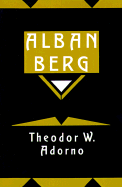Translators' introduction
Published online by Cambridge University Press: 03 May 2011
Summary
Theodor Adorno's study of Alban Berg is not a central work of his music-aesthetic oeuvre. It has neither the breadth of his Mahler and Wagner monographs, nor the didactic focus of his Philosophy of Modern Music and Introduction to the Sociology of Music. It is, instead, a personal document, consisting of reminiscences about a mentor who became a friend, and analyses of works with which the author had lived a lifetime. And yet, because this relationship was of such crucial importance to Adorno, these works so decisive in shaping his aesthetic precepts, Alban Berg, its modest scope notwithstanding, provides a key to understanding the philosopher and his thought – as well as offering a unique perspective on one of this century's most representative creative artists.
In many ways, Alban Berg: Der Meister des kleinsten Übergangs, published near the end of its author's life, is a reflection upon and testimonial to a fondly remembered starting point. For Adorno (1903–1969) that starting point was an encounter with the world of the so-called Second Viennese School that had crystallized around the teaching, music, and personality of Arnold Schoenberg. In a post-war era surfeited with “novelty,” the works of Schoenberg seemed genuinely “new,” an eruptive creative presence marking a crossroad one could ignore only at the peril of losing one's way into the future.
- Type
- Chapter
- Information
- Alban BergMaster of the Smallest Link, pp. viii - xivPublisher: Cambridge University PressPrint publication year: 1991



